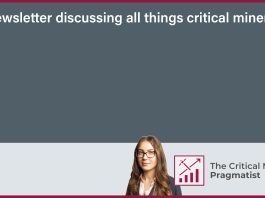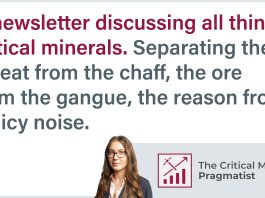Introducing the latest edition of The Critical Minerals Pragmatist, crafted by Olimpia Pilch. This newsletter offers a fresh and insightful take on the ever-evolving global landscape of critical minerals.
Antimony has probably been inescapable to most of you towards the end of last week as the Chinese Communist Party (CCP) announced a new series of export restrictions which came into place on 15th August. As always, Western media went into overdrive. There is hardly anything new happening with the restrictions to what we have seen with germanium, gallium (see my commentary in Bloomberg last year) and graphite. Some have misinterpreted this as an immediate ban, with the usual panic and buying ensuing. To clarify, this is not a ban on exports, but the CCP tightening its grip on the private sector, ensuring that companies must first obtain a license. Why the additional bureaucracy you may ask? Two reasons:
- Ensuring that antimony refined in China services the domestic market only rather than being exported and pushing up prices domestically is part of a wider manufacturing strategy for China to remain price-competitive.
- Knowing who is exporting where and in what quantities is a strategic mapping exercise to get better acquainted with one’s enemies’ weaknesses. In my humble opinion, every so often a new metal will make the headlines as the CCP continues to map out where it can strike the US and its allies most effectively, should the need arise.
See Reuter’s reporting on this. The most comprehensive and non-sensational take has been by Project Blue’s Jack Bedder.
Other “experts” have let themselves run wild with their imaginations. CSIS suggested that the US should pursue tapping into Tajikistan’s antimony. One needs to know little of geopolitics to point out why that would be such folly. Between strong Russian ties (Russia is Tajikistan’s largest trading partner) and being in China’s pocket (in 2011 Tajikistan ceded 4% of its land to China as part of a long-standing border dispute), and no easy export routes via Western-friendly nations… I’ll let you make your own conclusions about basing US security on access to Tajikistan’s antimony. Xi Jinping graced Dushanbe with his presence only last month. More here.
China won the Olympics
A picture has been circulating on X which has allegedly been floating around Chinese social media and communications apps. “Chinese media declared China the winner of the 2024 Olympics, by considering Taiwanese medals as Chinese medals.” Make your own conclusions.
If you want a good cackle at CCP propaganda in action – watch this.
“Where is the former Foreign Minister of China?”
“Somewhere in China, you will never see him.”
The West’s critical mineral policy is putting the cart before the horse
After panicking about rare earths, graphite, gallium and gadolinium, geopolitics pundits are busy brushing up on antimony, the latest critical mineral to fall subject to Chinese export controls. But to ascribe every tweak to Chinese industrial policy as a salvo in an ongoing trade war with the West is to misunderstand Beijing’s actual priorities. What is worse, paranoia over China is pushing Western policymakers into an incoherent “mining first” strategy that will do nothing to actually build lasting global supply chains.
Gadolinium is a rare earth…
Paranoia it may well be, but China chose its path as illustrated by Document No. 9. China does not see the US as a friend, and the entire West is led by the US as the offspring of crumbled empires.
Most other rare earth projects outside China have failed because they failed to develop similar relationships with buyers, focusing instead of hyping up political panic over-reliance on China.
Yes and no. It is true that Western miners rarely, until recently, thought of courting buyers. But then again, as the West offshored – those buyers were mostly in the Far East. Many have also failed as they were peddling crap projects or had clueless technical teams and directors intent only on mining stock exchanges. Then there is the difficulty of attracting finance before most people even heard of rare earths…
At first glance the Chinese government’s decision to restrict antimony exports looks like a case of mineral diplomacy, hitting out at Western economies by starving them of a critical metal. But on closer examination, the theory falls apart. Chinese domestic antimony mining has been in steep decline in recent years, as resources are exhausted. As a result, Chinese refiners have increasingly been sources of ore overseas, from Russia, Myanmar, and elsewhere.
Only an idiot would think restrictions are the same as bans…so starving the West of anything is a stretch. One can only assume there is a typo in there somewhere, but the author is not too far off. China’s demand has increased while mine production has been declining. If you can’t mine it at home, you have to naturally import it.
Meanwhile demand for the metal, which is a key ingredient in a huge number of high-tech applications, is growing steadily. By restricting exports, the government can control rising antimony prices and ensure affordable metal remains available within its own economy.
So, controlling supply is not price manipulation?
Geopolitical analysis of Chinese trade policy often assumes that authorities are playing a game of four-dimensional Chess. When China exports critical minerals cheaply, it is assumed that they are trying to outcompete Western miners and refiners. When China restricts exports, it is interpreted as an attempt to hurt Western manufacturers. But there is a much simpler, and less solipsistic interpretation: Chinese industrial strategy will always prioritise supplying Chinese manufacturers.
As any nation should. However, prioritising Chinese manufacturing means leaving Western manufacturers operating outside of China high and dry. This is where the West has the right to respond to protect its interests especially as China is openly anti-US – unfortunately, that response rarely goes beyond strongly worded press releases, MOUs, and roundtables with producer nations. Cash is occasionally sprinkled at projects that sound great on a polished slide deck, but have very little value once you look under the hood.
Western jurisdictions such as the EU and the US have suddenly realized the advantages of having an industrial strategy. This has sparked attempts by Western governments to develop critical mineral projects, either within their own borders or in friendly jurisdictions. But this strategy has yet to have much success in getting mines built. While Western governments labouriously compile their critical minerals lists, Chinese companies have been busy getting mines built and expanded, in Central Africa, Indonesia, and elsewhere.
That’s because Western industry and policy are not aligned. Policymakers want diversification of supply chains and greater investment into critical minerals projects. The industry (excluding miners and specialist mining capital) is content with lower-risk ventures.
The Western approach will not work because it puts the cart before the horse. No amount of mining will ever be enough to spur demand. But if the manufacturing sector can be revived, then there would not be a problem with supply.
To diversify supply chains, you would first need to at the very least double the existing demand to be able to theoretically create alternative supply chains on par with China’s. You’d need to triple demand yet to gain an edge over China, and quadruple to gain a comfortable dominance. This assumption would require Chinese supply, investment and growth of the critical minerals sector to remain static, while the West pours in trillions to essentially build what exists today four times over, and consumers run into the streets to buy solar panels, wind turbines, EVs and tech gadgets like it’s a Black Friday sale with 80% off discounts. I hope by now you are catching my drift – there’s a higher chance of woekism disappearing overnight (one can only pray!).
Where I disagree with the author, yet again, is that simply creating demand will not ensure supply. “Build it and they will come” is not a strategy but wishful thinking. Primarily due to the time lag. 20+ years to get a mine up and running in the US? Abysmal. Meanwhile, gigafactories can be built and operating in a year, or three months if you’re in China. So even if my unhinged scenario above, somehow magically came to be, the mines and resulting supply would not be coming from the West but the jurisdictions that are amenable to permitting mines pronto.
The free market is perfectly able to produce mineral supplies if those minerals are needed. But the reverse is not true. Forcing critical mineral projects into operation in the West will not magically revive long-neglected manufacturing sectors, particularly when those critical minerals are selected from lists compiled by bureaucrats rather than by actual demand.
*Screams internally in critical mineral pain*
THERE IS NO FREE MARKET IN CRITICAL MINERALS. They are called critical minerals because of geopolitical implications. Take China out of the equation and you’re left with just minerals.
One of my biggest pet peeves is the inability of many commentators to separate traditional commodities from the complexities of critical minerals (granted that the addition of commodities to critical minerals lists hasn’t helped). If the IEA released a report that coal demand would soar by 500% in the next twenty years, coal mines would be popping up like mushrooms after summer rain. The same is not happening in critical minerals.
Instead, even if the mines were built, the most likely outcome would be that all the rare earths, minor metals, copper, batter minerals, and whatever else is deemed “critical” in Brussels or Washington would just be shipped back to China, effectively subsidising their manufacturing sector even further.
Something we can agree on. This is why the Production Tax Credit Incentive in Australia is such a folly.
Is JORC now a flawed project?
Reporting on ESG factors – especially material ones – is fair enough. Again, there’s a reasonable amount of judgement to be used because, on a 15 year approvals average, whether or not the right to mine could be earned is a highly subjective issue – and especially early in the development trajectory of the project, one can argue there’s 1-15 years more to spend on sorting out these problems.
For a code that exists to prevent misleading investors about mineral assets, I think that ESG reporting and materiality clauses within JORC24 are going to have very little effect in preventing investors from feeling aggrieved.
The sustainable folk will have aneurisms over this, but I don’t believe ESG has any place in JORC. The purpose of reporting codes has always been to prevent the scamming of investors and losing their confidence in exploration. ESG is the biggest scam in the junior space. No one can actually agree on what good ESG looks like – and how could you as each project is different? Despite the myriads of standards now usefully moving towards convergence, there is an aspect of ESG that will always be hard to navigate – morality. A lot of ESG is based on doing what is “right”. However, in the woke West detached from the Christian values it has been built on, and taking into account the spectrum of global cultures, what is “right” looks very different to different people.
My initial thoughts on the inclusion of ESG in JORC over half a year ago were that it makes perfect sense. Yes, ESG factors such as community support and environmental consideration, alongside good governance will impact the reasonable chance of a project obtaining permits and reaching production. No community support, no project. However, this is opening a Pandora’s Box. Companies will greenwash the hell out of their claims. Eventually, investors will catch on, and lawyers will be busy. It’s one of those things that sounds great in principle, but will fail in practice – it’s just a matter of when.
It is also worth pointing out that lip service to ESG will be the norm, judging by the attitude of this recalcitrant and recidivist industry and its members on this platform. We can hardly expect an industry that treats ESG as ‘woke crap’ to do more than cut and paste boilerplate statements into their Public Releases.
Amen.
So, I guess the industry should not worry overmuch about the impost of ESG reporting in JORC24 and Public Releases, because it’s all just hot air and meaningless bloviating, while the industry gets on board with Juukaning their way through life.










